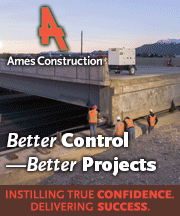
Design-Build in Transportation Includes Ports and Rail
Andrew Ausel | May 18, 2016
One of the topics most-discussed by attendees of this year’s Design-Build in Transportation Conference was the need for more coverage of transit projects other than highways. Well, last December, for the first time in ten years, long-term funding for surface transportation was achieved when President Obama signed the Fixing America’s Surface Transportation (FAST) Act into law, and the legislation not only provided major funding for our roads, but also for our ports and freight-related transit. The FAST Act set aside $4.5 billion in discretionary grants for projects that benefit freight movements, and $6.3 billion through a freight formula program. Although critics pointed out that much of this funding was limited to highway projects, this legislation undoubtedly embraced freight and rail in a more systematic fashion.
The Problem?
In the months leading up to the passage of this bill, stakeholders and key players identified the improvement of our nation’s ports and rail lines as essential to an effective funding package. Kurt Nagle, President and CEO of the American Association of Port Authorities (AAPA) wrote in a piece published last November, “We must look at intermodal connectors between surface transportation networks and ports. These connectors account for roughly 1,200 of the 57,000 miles of the national highway system.”
Although freight funding scored a victory in the FAST Act, freight and port projects often have trouble finding and competing for transportation funding. In a statement outlining the need for freight funding, the Department of Transportation noted, “These projects face competition from non-freight projects for public funds and community support, a lack of coordination among various government entities and private sector stakeholders, and limited availability of public funds to address the key freight chokepoints where those actors individually have less of an incentive to invest.” In a 2012 report, the American Society of Civil Engineers projected an estimated $15.8 billion investment gap in port funding by the year 2020. In a more recent study surveying the AAPA’s U.S. member ports, the AAPA found that a lion-share of the funding for these projects will come from the private sector — in fact, the projections anticipate $154.8 billion of funding will come from the private sector, with only $24.8 billion from the federal government.
How Does Design-Build Fit In?
It almost sounds like an advertisement for design-build at this point. Difficulty in locating public funding? Expect a high level of inter-governmental coordination? Better use Design-Build! Although this pitch isn’t actually being made, redevelopment of ports and freight systems could actually be enhanced by design-build. And both federal and state players have realized this as well. As a boon to economic development, the U.S. DOT is developing tools for port authorities that can attract private investment through a P3, and has urged smaller authorities to utilize TIGER grant funding which can be accessed by projects of economic significance. Even in state houses, we have seen efforts to ensure ports can be improved via design-build. For example, legislation in Mississippi, HB 506, extended design-build authority for the port of Gulfport, Mississippi until 2020, shoring up a major share of the state’s design-build authority.
DBIA and its committees have recognized this trend and are developing plans to further incorporate related programing into our conferences and outreach. Whether it’s enabling legislation or introducing public owners to our events, promoting design-build for ports will follow much of the same model we have used for promoting design-build in general. We have seen and will continue to discuss how design-build has succeeded in improving our highway system, but only through building upon this foundation can we expand the discussion and define Design-Build Done RightTM for these other crucial modes of our transportation network.
<< Missouri Passes DB Legislation | Federal Legislation is Moving!>>
Related Stories:
How the Final Highway Bill Impacts Design-Build








